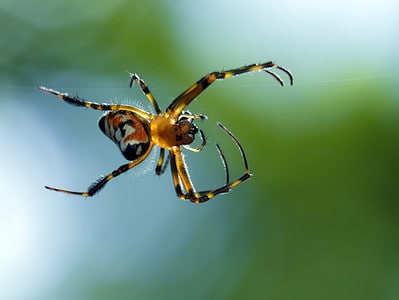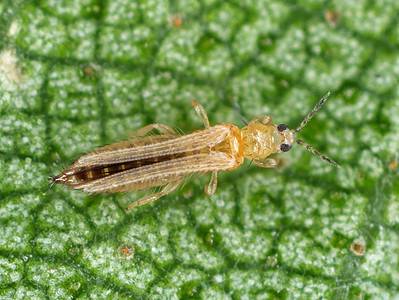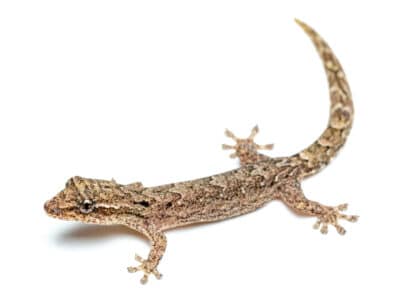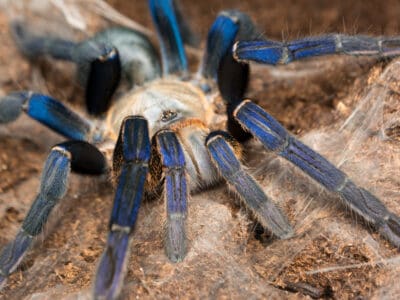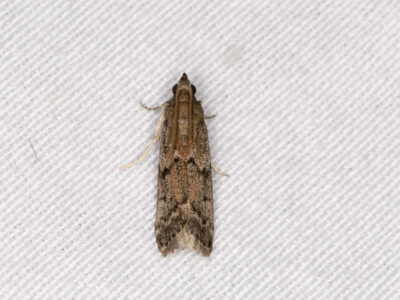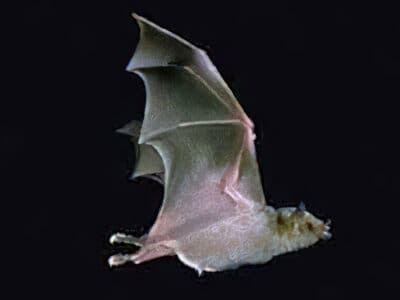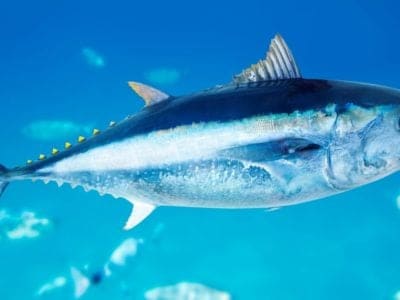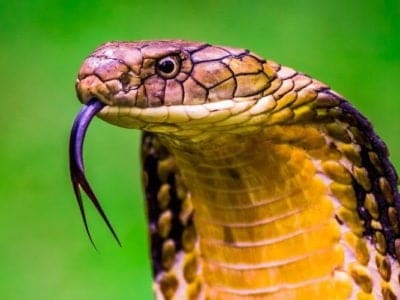Finch
Finches have strong, conical bills that help them break open tough seeds that many other birds cannot.
Advertisement
Finch Scientific Classification
Read our Complete Guide to Classification of Animals.
Finch Conservation Status
Finch Facts
- Prey
- Insects and other arthropods
- Name Of Young
- Chicks
- Group Behavior
- Colonial Nesting
- Flock
- Pair
- Fun Fact
- Finches have strong, conical bills that help them break open tough seeds that many other birds cannot.
- Biggest Threat
- Invasive species, predation, habitat degradation
- Most Distinctive Feature
- Stout, usually conical bills
- Distinctive Feature
- Wide range of colors
- Habitat
- Usually wooded areas
- Predators
- Domestic and feral cats, owls, hawks, blue jays, grackles, crows, chipmunks, squirrels, rats, skunks , snakes, raccoons
- Diet
- Omnivore
- Lifestyle
- Diurnal
- Flock
- Pair
- Favorite Food
- Seeds
- Location
- Every continent except Antarctica
- Group
- Flock
- Nesting Location
- Mostly in trees or shrubs, on ledges, or on artificial structures
Finch Physical Characteristics
- Color
- Multi-colored
- Skin Type
- Feathers
- Lifespan
- Variable by species; 4 to 20 years
- Venomous
- No
- Aggression
- High
Finches have strong, conical bills that help them break open tough seeds!
What is a finch? That question has perplexed scientists for decades. It has only gotten more difficult to answer as groups of birds have been moved from one family to another based on DNA analyses since the 1990s. Small, usually colorful birds with strong, conical bills were originally grouped together based on their looks. It turned out many of them developed similar traits separately from any common ancestor, possibly due to similar environmental pressures. Other birds that didn’t look so much like finches at all, like the honeycreepers from Hawaii, turned out to be close relatives. Let’s take a closer look at the true finches of the Fringillidae family and the other birds around the world that share their name.
Incredible Finch Facts
- True finches are members of the Fringillidae family, which contains more than 200 species.
- Birds commonly known as finches also belong to a number of other families, including Estrildidae, Emberizidae, Passerellidae, Thraupidae.
- The classification of finches has been evolving rapidly since DNA testing of birds began in the 1990s. Some groups are still in flux.
- Finch populations range from hundreds of millions of some species to just a few hundred or less of others.
- Finches are lovely singers, and many individuals sing multiple songs and can learn new ones.
- Finches mostly eat seeds, but many also eat fruits, insects and other arthropods, and even nectar.
Where to Find Finches
Finches can be found almost all around the world. There are hundreds of species and subspecies of finches, including the true finches of the Fringillidae family and members of other families commonly known as finches. These birds are typically found in or near wooded areas. They utilize both deciduous and coniferous forests. As omnivorous, but primarily granivorous birds, finches are likely to frequent areas with lots of vegetation such as grasses, weeds, shrubs, or trees that provide seeds and fruits.
Finches often flock together and many species are drawn to areas inhabited by humans. Some simply utilize bird feeders, but others feed aggressively from agricultural developments including field crops and orchards. Various finches have been considered pests due to this behavior, and some species have been persecuted nearly to the point of extinction.
Finch Nests
Finches usually nest in trees or sometimes shrubs. Depending on the species, they also nest on ledges or in crevices in rocks. The top of a cactus or a woodpecker hole might make a good nest site. Finches may also use artificial locations, such as hanging planters, nest boxes, bird houses, or parts of human dwellings. The size and shape of finch nests vary according to species.
House Finches make messy cup-shaped nests from leaves, twigs, grass, hair, wool, and other materials, often in a sheltered spot on a human dwelling. Goldfinches usually make smaller, tightly-woven, cup-shaped nests in shrubs in open areas, made of grass and lined with fluffy plant from grassy seed heads. Chaffinches typically build cup-shaped nests in trees, tightly constructed from grasses, twigs and moss and lined with feathers and wool. Grosbeaks make messy, loosely-constructed nests of twigs, grasses and weeds in larger trees or shrubs. There are so many different types of finches, and their nests vary accordingly.
Finch Scientific Name
True finches belong to the Fringillidae family. That family contains more than 200 different species, currently categorized into three subfamilies: Fringillinae, Carduelinae, and Euphoniinae. Since the 1990s, when scientists began rearranging bird families based on DNA, many changes have been made in avian taxonomy. Birds long thought to belong together were split into different families, and seemingly unrelated birds were put together based on genetic connections.
Fringillinae
The Fringillinae subfamily contains the genus Fringilla, which includes just four species, three chaffinches and the Brambling. One of these species is the amazingly prolific Common Chaffinch, which ranges over much of Europe, Asia and parts of Africa. Its population is estimated at 500 million to 800 million mature individuals and increasing. The genus also includes the Gran Canaria Blue Chaffinch, which has the coloring of a Blue Jay and the shape of a House Sparrow. This endangered bird endemic to the Canary Islands has a population of just 430 mature individuals.
Euphoniinae
The Euphoniinae subfamily includes the genus Euphonia and the genus Chlorophonia. The members of each of these genera are native to South America, Central America, Mexico and the Caribbean. These are among the most colorful finches, with individuals sporting plumage in bright yellows, oranges, blues, violets, and various shades of green. There are currently a little over 30 species assigned to this subfamily, with some recent disagreement about how to classify a few species within existing genera.
Carduelinae
The Carduelinae subfamily is by far the largest within the Fringillidae family. Nearly 50 genera and more than 180 different species make up this subfamily. Cardueline finches include such birds as goldfinches, rosefinches, bullfinches, greenfinches, some types of grosbeaks, the Hawfinch, siskins, serins, canaries, crossbills, redpolls, and a number of other finches of various types.
Hawaiian honeycreepers, a group of more than 40 different species formerly categorized under the Drepanididae family, now belong to the Carduelinae subfamily. They were moved to the Fringillidae family after DNA analysis revealed their close relationship to rosefinches. The honeycreepers have some of the most diverse features of any of the finches, especially with regard to bills and tongues. Among this group are multiple critically endangered and extinct species, including the Poo-uli, which was last seen in 2004.
Other Finches
There are many other birds called finches around the world. Most of these were called such because of their appearance, their behavior, and perhaps their proximity to birds known as finches. The ability to classify birds based on their genetic markers and common ancestors is a relatively recent development in ornithology. Therefore, the accepted taxonomy of birds and other animals continues to change as our knowledge increases.
Some of the so-called finches that are not part of the Fringillidae family are the members of the Estrildidae family. This family includes more than 140 species which live primarily in Oceania, including Australia, New Zealand and many nearby islands. Zebra Finches, the popular pet, are among the many Estrildid finches, as are the multicolored Gouldian Finches.
Additional birds known as finches can be found in the Emberizidae family, comprised of buntings, and the Passerellidae family of sparrows. The famous group of species known as Darwin’s finches, of the Galápagos Islands, are now part of the Thraupidae family of tanagers.
Appearance
When one mentions a finch, what comes to mind? Is it a bright yellow and black American Goldfinch? Perhaps a round, rosy-breasted Eurasian Bullfinch with a dapper black cap? Or maybe a little brown House Finch with a reddish-purple head. There are simply too many different finches to give a simple description that encompasses them all.
With a few exceptions, mainly the Hawaiian honeycreepers, finches have conical bills. Some are quite large, and others are smaller, but they share a basic cone shape that is sturdy enough to break open tough seeds. Finches are generally small birds, ranging in size from the tiny Lesser Goldfinch, which can be as small as 3.5 inches long and 0.28 ounces to comparatively huge grosbeaks which can reach 10 inches in length and more than 3 ounces.
Most true finches are sexually dimorphic. The males typically have much brighter colors and variegation than the females, although some species are predominantly dull. Even then, male finches usually exhibit measurably stronger colors or patterns.
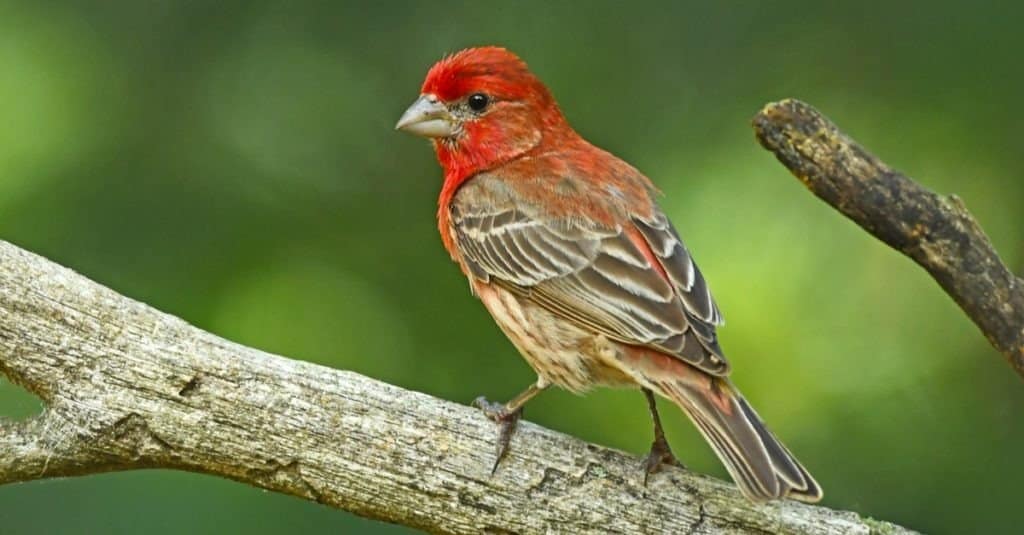
A male House Finch sits on branch.
©Brian A Wolf/Shutterstock.com
Behavior
The behavior of finches varies from species to species. For instance, many finches migrate while others stay in the same place all year. Some finches have adapted to live in very close proximity to humans. They eat from feeders and might make their nests in planters or on ledges on human dwellings. Other finches only come so near as to feed from crops or orchards. And still others keep their distance from people.
Finches are very social birds and often form large flocks. Some, like the Pine Siskin, form flocks of thousands and even nest in colonies during breeding season. They may comingle with other species or aggressively challenge them for resources.
Finches are generally diurnal. They are usually quite vocal, singing through the day, or perhaps more so during the morning or near dusk. Finch songs are described as sweet or melodic. Most of these birds can sing multiple songs, and can learn new songs as they are exposed to them through mating or in flocks.
Diet
Most finches eat primarily seeds. The typical finch bill is conical and strong. It is made for cracking open tough seeds, so finches don’t depend on just what has fallen to the ground. Many of these birds also eat a variety of arthropods, including insects, larvae and spiders. They are more likely to pluck them from stems or the bark of trees than to hunt for them on the ground. Some finches eat fruits from trees or shrubs, and some, including honeycreepers, have adapted to eat nectar.
Reproduction
Most finches make cup or saucer shaped nests of one variety or another, utilizing the plant materials that they find in their environment. Some finches are very careful about how they fashion their nests, with their construction so tightly woven it can hold water. Others seem to throw together materials in a haphazard manner and call it good enough. Finches usually line their nests with softer materials, including fine grasses, rootlets, animal hair or wool, and feathers before laying their eggs. The number of eggs varies according to species, but somewhere between 2 and 5 seems to be about average.
Some finches may be monogamous for multiple seasons, or perhaps even for life. Others find new mates each season. Some, like the Scarlet Rosefinch, also known as the Common Rosefinch, engage in extra-pair mating to increase reproductive success.
Finches typically have a short incubation period of two weeks or less. Depending on the species, the female may incubate the eggs alone, or the pair may take turns on the nest. The nestling period is usually between about 12 and 18 days. Both parents usually help feed the young both before and for a little while after they fledge.
Finches may have multiple broods per year. House Finches have up to six broods per year, and often return to the same nest site if it is not blocked.
Predators
Finches face a number of predators in the wild, not the least of which are domestic cats. Introduced species such as cats and rats have wreaked havoc on endemic bird species, including finches limited to small island habitats. These non-native predators have been significant to the extinction of multiple finch species.
Finches are also vulnerable to hawks, owls and other birds of prey. More significantly, they often suffer losses to nest predators. These include other birds such as crows, grackles, and jays. Snakes and small mammals such as chipmunks, squirrels, skunks, and raccoons are frequent nest predators, too.
Lifespan
Like so many other qualities, the average lifespan of a finch depends on the species. Across the different species in the Fringillidae family, the maximum expected lifespan in the wild seems to range between about 9 to 12 years. The average lifespan for those species that have been studied thoroughly enough to have data is much shorter. They average as little as 2 to 5 years in the wild.
The IUCN Red List for Threatened Species assesses finches and other bird species individually, taking into account their estimated population and other factors. Most finches are listed as species of least concern, although there are many species listed as near threatened, vulnerable, endangered, critically endangered or even extinct. Some factors that have contributed to the decline of these species include habitat destruction and fragmentation, introduction of non-native species, persecution by humans, and climate change.
Similar Animals
- House Finch – Perhaps the most common Cardueline finch in North America. This finch is a frequent visitor to bird feeders and may be found nesting in hanging plants.
- Eurasian Bullfinch – This rose-breasted bird with a black cap is one of the most common finches in Europe, Asia and parts of Africa. They have even been spotted in Alaska.
- Pine Siskin – This small finch is not as brightly colored or patterned as many other members of the Fringillidae family. As such it is often mistaken for a sparrow.
Finch FAQs (Frequently Asked Questions)
What do finches look like?
Finches vary widely in appearance, with a vast array of colors and patterns. They are, however, generally small birds with strong, conical beaks. Honeycreepers are an exception, as some have adapted to have long, curved beaks.
How big are finches?
Finches are typically small. They range in size from about 3.5 inches long and 0.28 ounces to around 10 inches in length and more than 3 ounces.
How many varieties of finches exist?
More than 200 species of true finches in the Fringillidae family are currently recognized. Many more birds commonly known as finches belong to other families.
What makes finches special?
Finches have strong, conical bills that help them break open tough seeds that many other birds cannot.
Where do finches live?
Finches live across most of the world. They are typically found in or near wooded areas. They utilize both deciduous and coniferous forests. As omnivorous, but primarily granivorous birds, finches are likely to frequent areas with lots of vegetation such as grasses, weeds, shrubs, or trees that provide seeds and fruits. They often live near humans.
Do finches migrate?
Many finches migrate, but others do not. Some are endemic to small areas, such as islands. Some migrate long distances each year, and others stay in the same general area or migrate only short distances.
What do finches eat?
Finches eat mostly seeds. They also eat insects and other arthropods. Some finches also eat fruits and some have adapted to eat nectar.
How many eggs do finches lay?
The number of eggs a finch lays varies based on the species, but it is usually between about 2 to 5 per clutch. Different species also have different numbers of broods each year. House Finches, for instance, can have up to 6.
When do finches leave the nest?
After an incubation period that lasts typically 2 weeks or less, finches usually leave the nest between about 12 to 18 days, depending on the species.
How long do finches live?
The average lifespan of most finches is not known, but for those with enough data the average seems to be between about 2 to 5 years in the wild, with a maximum between about 9 to 12 years.
Are finches rare?
Some finches are quite rare, and some have gone extinct as recently as the last 20 years. Other finches are among the most numerous birds on the planet, with hundreds of millions of estimated mature individuals. Finches are classified by individual species by the IUCN Red List of Threatened Species. Most are considered species of least concern, but others are listed as near threatened, vulnerable, endangered, critically endangered, and even extinct.
Thank you for reading! Have some feedback for us? Contact the AZ Animals editorial team.
Sources
- Tomáš Albrecht, et. al., Available here: https://academic.oup.com/beheco/article/18/2/477/204475
- William L. Thompson, Available here: https://sora.unm.edu/sites/default/files/journals/condor/v062n04/p0245-p0271.pdf
- Tennessee Wildlife Resources Agency, Available here: https://www.tn.gov/twra/wildlife/birds/forest-birds/pine-siskin.html








